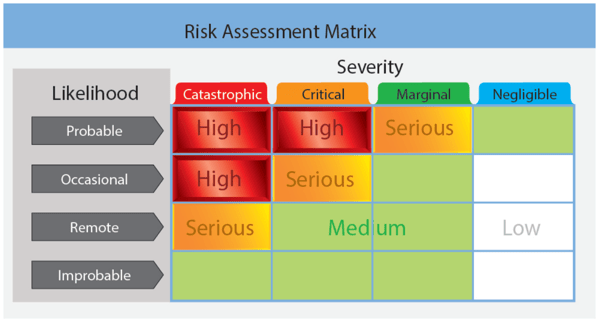When Is a Flight Too Dangerous To Make?
Q: How can I decide if a flight is too dangerous to make before I depart?
A:
Thank you for that important question. It’s a very simple matter of asking, “Is your name Capt. Harv?” If it is, you are good to go. But it’s not, so sorry. Fortunately, there is this thing called the risk assessment matrix that can help mortals such as yourself.
You should have studied the risk assessment matrix — or 'FRAT' as our friends at the Federal Aviation Administration call it — at least once in your flying career when you were working toward your private pilot certificate. If that was not the case, take this time to find your old instructor and flog them with a rubber garden hose.
Done? Ok. Here’s the risk assessment matrix as presented in the Pilot’s Handbook of Aeronautical Knowledge.

Understanding the Risk Assessment Matrix
The risk assessment matrix asks the pilot to consider the likelihood of an event occurring during a flight and to assign a level of severity to that event should it occur.
For the sake of clarity, here is an extreme example. You tug your 1939 Beech Staggerwing out of the hangar for a quick lap around the pattern, knowing full well it has little to no engine oil. If you were to fire it up and take off anyway, there is a probable likelihood that a catastrophic event would take place. Namely, just as you’re climbing through 100 feet AGL your engine would go on strike.
On the other hand, let’s say the only thing you notice to be amiss is remembering that it might be time to replace the battery in your super awesome aviator wristwatch, but it seems to be working at the moment. It is improbable that your watch will stop working during your 20-minute flight, and even if it did, your flight is not dependent in any way on having a functioning watch since you are only flying the pattern once in VMC. So, a dead watch battery would represent an event of negligible severity.
But the matrix shows its true power when helping you figure out if something a little more subtle could wreak havoc with your flight. Usually, it’s a weather-related issue where the matrix shines brightest by forcing you to imagine what-if scenarios. Say you are planning to race an oncoming frontal system to your intended destination. Using the matrix and good weather-forecasting products like progs and TAFs, you are compelled to imagine both the likelihood of encountering nasty weather and how bad it would be if you did. In turn, that makes you realize that even a quick pitstop for bladder relief along the way could move the likelihood of encountering the stormy weather up the chart.
Another thing you can use the matrix for is to reassure yourself that if you must divert, delay, or cancel your flight, it’s not the end of the world. If the likelihood of not making it to your favorite $100 hamburger joint suddenly becomes probable due to some external factor, the severity of that event is negligible compared to the severity of plane-crushing wind shear.
We should lay off the burgers anyway.
Understanding PAVE
Now, are you still wondering how to make sure you have thought of everything you need to consider with the risk assessment matrix? Of course, you are! But that’s why I'm here.
PAVE, P-A-V-E, is an acronym you can use to divide the risks of flight into four categories: Pilot, Aircraft, enVironment, and External.
- Pilot is you. How are you feeling? Did you plan your trip well? Are you current? Are you proficient?
- Aircraft is your aircraft. How’s she feeling? Is she current? Weight and balance all good? Feeling confident about runway lengths and the conditions at both ends of the flight? You get the picture.
- enVironment is all the stuff outside like weather, terrain, airspace, time of day, and season.
- External relates to external pressures like the desire to impress someone, get-there-itis, and acknowledging the difficult reality that you're not Capt. Harv.
But don’t get too down about it. Using PAVE to identify possible problems, and the risk assessment matrix to analyze each element will help you become just a little bit more like me.
Capt. Harv is the greatest pilot to ever live...if you ask him. When he isn't flying circles around you without ever leaving straight-and-level flight, he's straightening out your questions about aviation on the worldwide web. Follow him on Twitter and YouTube to become a better pilot.
Share this
You May Also Like
These Related Articles

How Do You Become a Proficient Pilot?

How Do You Handle an Engine Failure on Takeoff?
